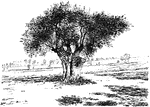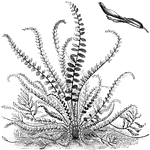
Astragalus Monspessulanus Habit and Flower
The flowers on the astragalus monspessulans shrub are usually purplish. This species grows in south…

Babiana Stricta Rubro-Cyanea
Babiana Stricta Rubro-Cyanea is a bulbous plant found in South Africa. The upper half of the perianth…

Barnadesia Rosea
Barnadesia is a deciduous shrub; it sheds its leaves annually. Barnadesia rosea has solitary, rose colored…
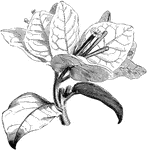
Flowering Branch of Bougainvillea Spectabillis
The bracts of bougainvillea spectabilis are a dull, brick red shaded with scarlet. Bougainvillea is…
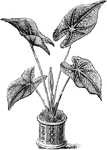
Caladium Maculatum
Caladium maculatum leaves are heart shaped at the base. The leaves are spotted with clear white. This…

Calondendron Capensis
The flowers of the calodendron capensis tree are flesh colored. The tree grows forty feet tall. This…
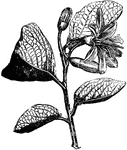
Flowering Branch of Calycanthus Floridus
The common name of calycanthus floridus is Carolina Allspice. The flowers have a sweet, apple scent.…
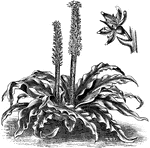
Eucomis Punctata
Eucomis punctata is native to South Africa. The flowers are green and brown. The leaves are oblong and…
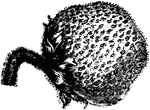
Fruit of Fragaria Chilensis
The common name of fragaria chilensis is the chili strawberry. The fruit is rose colored on the outside…

Branch of Inflorescence and Single Flower of Fucraea Gigantea
Fucraea gigantea flowers are milk white on the inside and greenish on the outside. The scape is between…

Hybrid Hippeastrums
Hippeastrums are native to tropical South America. The flowers range in color from red to white. Some…
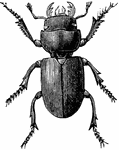
Small Stag Beetle
The small stag beetle is common in the south of England. Small stag beetle is the common name of dorcus…
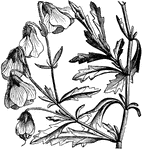
Flowering Branch of Mahernia Glabrata
The flowers of mahernia glabrata are yellow and drooping. The flowers bloom April to June. The flowers…
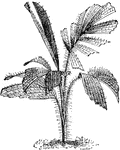
Martinezia Erosa
Martinezia erosa is a stove palm native to South America. The stalks and blades have long, brown, needle…

Pellaea Hastata
Pellaea hastata fronds are six inches to two feet long. The fern is native to South Africa.

Northern Spy Monument
Pictured is a four feet tall Northern Spy Monument. The tablet reads "The original northern spy apple…
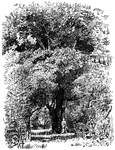
Avocado Tree
Avocado is a tropical fruit tree. The avocado is considered to be native to Mexico, Central America,…

Ceratopteris Pteridoides
Ceratopteris pteridoides ferns can be found from Florida to South America. The sterile leaves are short…
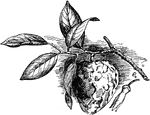
Cherimoya
Illustrated is a smooth form of cherimoya. It is a subtropical fruit tree. In South America the smooth…

Cleome Spinosa
The common name of cleome spinosa is giant spider plant. The plant is clammy, strong scented, and grows…

Clethra Tomentosa
The common name of clethra is white adler. The tomentosa variety grows two to eight feet tall. It is…
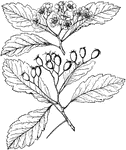
Crataegus Tomentosa
Crataegus tomentosa grows to twenty feet with spreading branches. The fruit is usually oval, dull yellow…

Crocus Vernus
Crocus vernus is the most common garden crocus. The flowers are lilac, white, or purple striped with…

Cymbopetalum Penduliflorum
Cymbopetalum penduliflorum has several common names including Mexican earflower and sacred earflower…

Cypripedium Spectabile
Cypripedium spectabile is a stout plant. The flowers bloom in June. It is found from Maine, New England,…
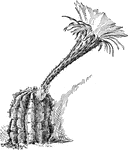
Echinopsis Gemmata
Echinopsis gemmata is native to south Brazil. The flowers are clear white with a pale greenish midline…
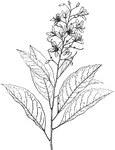
Elliottia Racemosa
The elliottia racemosa shrub grows four to ten feet tall. It is native to the wet, sandy woods of South…
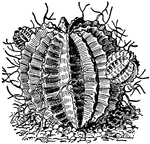
Melon Spurge
Melon spurge is the common name of euphorbia meloformis. It is native to South Africa. It is often mistaken…

Silver Tree
Silver tree is the common name of leucadendron argenteum. The branches are densely leafy. It is native…
Liatris Spicata Montana
Liatris spicata montana grows ten to twenty inches high. The flowers are blue purple. It is native to…
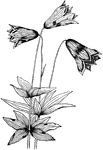
Lilium Grayi
Lilium grayi is native to North Carolina and Virginia. The flowers usually hang more loosely than how…

Lobelia Erinus
Lobelia erinus grows six to twelve inches high. The plant is native to South Africa. It is a common…
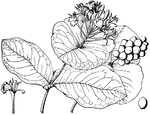
Lonicera Flava
The lonicera flava shrub climbs ten feet high. The flowers are orange-yellow and fragrant. It is native…

Currant Tomato
Currant tomato is also known as German raisin tomato. The fruits are small and red, currant like. It…
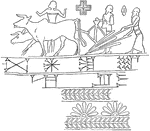
Babylonian Seal Impression
Pictured are men plowing a sowing. This illustration is from a Babylonian seal impression from the 14th…

Ice Plant
The flowers of the ice plant are small, whitish or varying to light rose color. It is native to South…

Micromeria Piperella
Micromeria piperella grows a few inches high and has slender, arching branches. The flowers are purple…

Nemesia Strumosa
Nemesia strumosa is native to South Africa. The flowers are white or in shades of yellow and purple.…

Power House
A diagram of a cross-section of a power station at the South Side Elevated Railway Company in Chicago.…

Argentine Ant
Image of an Argentine ant. This destructive insect is native to parts of South America, but was accidentally…

Head of Gems'bok
This illustration shows a head of a Gems'bok. A Gems'bok (Oryx Gazella) is a species of South African…

Jute
Jute, also known as Calcutta Hemp, is a fiber obtained from several species of the genus Corchorus of…
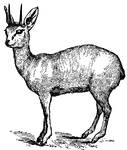
Klipspringer
The Klipspringer, or Kainsi, is a small but very active antelope (Oreotragus saltator), found in the…

Human Leg (Front View), and Comparative Diagrams showing Modifications of the Leg
This illustration shows a human leg (front view), and comparative diagrams showing modifications of…

Leg of Seal
This illustration shows the leg of a seal. P. Pelvis, FE. Femur, TI. Tibia, FI. Fibula, TA. Tarsus,…

Turbo Generator
Sectional elevation of the 31,000 h.p. turbo generator units used in the Yadkin River development (North…

Compass Card
Ritchie Liquid Compass. US Naval compasses have the degree around the rim marked from 0 to 360, east…

Coat of Arms
Coat of arms for the French Republic and Imperial Arms of France. France is the most western portion…

Puma
The puma, also known as the cougar, panther, or mountain lion (Felis concolor) , is a large American…

Visigoths, Under the Rule of Alaric, on the March after Sacking Rome
Illustration of a great multitude of Visigoth warriors, along with the booty they had taken from Rome,…

The Siege of Château Gaillard, the Saucy Castle of Richard the Lionheart - Aerial View
An aerial view of the siege of Château Gaillard, also called the Saucy Castle. Construction of the…

Prickly Saltwort
Salsola kali. This plant is also called a Russian Thistle, Prickly Glasswort, Tumbleweed, and Glasswort.…
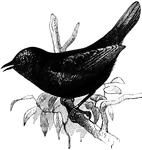
Magellanic Tapaculo
Scytalopus magellanicus. "A genus of South American formicarioid passerine birds, of the family Pteroptochidae.…

Elephant Seal on a Rock
"The seal Macrorhinus elephantinus or proboscideus, or Morunga proboscidea. It is the largest of the…

Seal Swimming up to an Igloo
Illustration of the entrance of an igloo, built out of ice, partially underwater. A seal is swimming…

Leopard Seal
Leptonychotes weddelli. "A spotted seal of the southern and antarctic seas, belonging to the family…

Seal Press
"A press or stamp bearing dies on its jaws, or a die and a bed, for imprinting or embossing any device…

Skippet - Open Box with a Seal Inside
"A circular box used for covering and protecting a seal. Old documents were commonly sealed by means…
